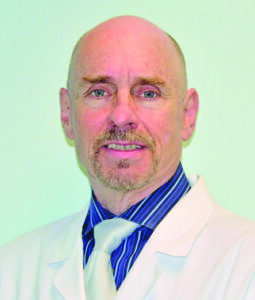Health Matters: Why do hammertoes develop?

Dr. Conway McLean
The human body is prone to an extensive list of ailments, some more benign than others. Some of the more deadly types aren’t as common as your everyday hammertoe, one of the most common developmental deformities of our species. They may be common but, surprisingly, most people haven’t a clue as to why or how they occur.
Perhaps an appropriate question at this juncture concerns the definition of a hammertoe. Generally speaking (but not technically), it is a toe that is bent down or over in some fashion. For specialists, there are specific terms for every possible bend and twist of a digit and believe me when I say there are innumerable angulations possible. (I’ve seen toes do some pretty strange things.)
How does this happen? What leads to the gradual twisting and bending of our toes? These are relevant questions if you are experiencing these changes. And chances are decent that you are. After all, some estimates claim as many as a third of one population group, senior citizens, are afflicted with them.
Constrained in a shoe as they are, any disturbance in position from “normal” is likely to cause pressure somewhere to a misaligned toe. Surprisingly, problems can also develop to the foot, especially the ball of the foot. A bent toe will tend to put pressure on top of the metatarsal bone, as opposed to the end of the bone as is appropriate. This pushes the bone down, causing greater pressure to the ball of the foot and pain can develop.
It’s a surprisingly complex answer as to why hammertoes develop. Joints are mobile, and thus they are able to take many positions. Because the joints at the ball of the foot are minimally constrained, able to move in various directions, any change in the structures pulling on the toe will lead to an imbalance. Voilà, the toe will be pulled out of position.
Probably the most common reason for the development of hammertoes is the frequently seen pronation syndrome. the most common biomechanical pathology on the planet. This is the term for an arch that rolls down too much. With even the slightest increase in this falling motion of the arch in gait, the tendons running to the toes will be pulled out of alignment.
Early on, the bending of the toe will occur only when a person is walking. But due to the repetitive nature of gait, the changed position of the toe becomes more fixed. Initially, the soft tissues around the joint become adapted to the contracted position, making the deformity flexible. With time, the bones are altered as well, rendering the joint fixed. The toe can no longer be straightened, even manually.
The average individual takes 5 to 10,000 steps a day every day…..day after day…..365 days a year. Multiply that times the number of trips around the sun. This is an essential component of why these developmental (people aren’t born with them) deformities are seen in seniors more than young people.
Pronation and its counterpart supination are supposed to occur with each and every step. But too much of anything in biomechanics will lead to problems eventually, whether it’s deformity or pain, or both. Many other problems can be produced by these too-common deviations from “normal” function and alignment, including calluses or corns, low back syndrome or slipped discs.
Many examples of improper foot function can be treated surgically but should not be. It is true: function will likely be changed by altering anatomy. But much more benign, and less expensive, with far less risk of complications, is a directed stretching/strengthening program with the use of specialized, custom foot/body supports typically referred to as foot orthotics.
Unfortunately, one of the most frequent reasons for strangely twisted toes is the aforementioned surgery performed on a toe. Depending greatly on the type of procedure performed, and there are many, disruption too often occurs in one of the structures stabilizing the joint and the toe angles away from the desired alignment.
Abnormal biomechanics can be diagnosed and should be treated. But this is a niche field of medicine, typically underappreciated and unrecognized. Through the careful analysis of gait and anatomy, these deformities are predictable and even preventable. Recognizing the presence of excessive pronation, understanding the signs of impending complications, treating the various issues resulting in a collapsing arch or one of the other foot types leading to hammertoes, these are possible. Our health and well-being would benefit if this analysis became an everyday facet of modern medical care. Prevention is worth a lot, like a lot of bent toes!
Dr. Conway McLean is a physician practicing foot and ankle medicine in the Upper Peninsula, with offices in Escanaba, Marquette, and L’Anse. McLean, who has lectured internationally on wound care and surgery, is board certified in surgery, orthotic therapy and wound care. His articles on health and wellness appear in multiple local and national publications.






